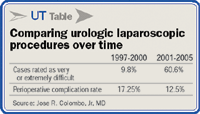Article
Laparoscopic procedures are safe for urologic malignancies
Laparoscopic surgery for urologic malignancy is associated with a low perioperative complication rate, and the rate has decreased over time despite the increasing performance of more challenging cases.

At the AUA annual meeting, Jose Colombo, Jr, MD, presented findings from a review of 1,867 laparoscopic procedures for urologic malignancies performed between February 1997 and January 2006. Data were extracted from the electronic medical records pertaining to demographic and historical information as well as perioperative data and complications occurring within 6 weeks of surgery.
The overall intraoperative complication rate in the series was 3.5%. Hemorrhage, defined by blood loss higher than 1,000 mL and/or need of open conversion and/or blood transfusion, accounted for about two-thirds of those events. The open conversion rate was 0.9%. Postoperative complications occurred in 8.9% of patients, with hemorrhage again being the most common event (2.7%). There were eight deaths in the series, for a mortality rate of 0.4%.
"We believe our data provide a basis for proper preoperative risk counseling and modification of procedure-specific techniques to further minimize complications and improve patient care."
The patients in the series had a mean age of 60 years, almost three-fourths were males, and 20% had previous abdominal or pelvic surgery. Use of the European Scoring System (ESS) for laparoscopic surgery for case categorization showed 40% were difficult (radical nephrectomy, nephroureterectomy), 27% were very difficult (partial nephrectomy), 32% were extremely difficult (radical prostatectomy), and radical cystectomy accounted for 1.6% of cases.
The mean blood loss for patients in the series was only 200 mL, and in 90% of the patients, blood loss was less than 500 mL. The average operative time was 3.4 hours, and 70% of cases were completed within 2 to 4 hours, while 20% took longer than 4 hours.
After hemorrhage, urine leakage (0.6%) and anastomosis leakage (0.2%) were the most common postoperative surgical complications. Rates of postoperative medical complications in the series were low. Acute renal failure occurred in 0.8% of patients; all pulmonary complications combined (pulmonary embolism, pulmonary edema, pneumonia) occur-red at a rate of 0.9%; and atrial fibrillation and deep vein thrombosis each occurred at rates of 0.3%.
The investigators also calculated the incidence of perioperative complications with the cases stratified by ESS score. That analysis showed the complication rate was highest for radical cystectomy (48%) followed by the very difficult procedures (23%). A complication occurred in 13.5% of the difficult procedures and in only 6.7% of the extremely difficult procedures.
Using multiple logistic regression analysis, features found to be independent predictors of developing at least one perioperative complication included radical cystectomy, partial nephrectomy, preoperative abnormal renal function (serum creatinine ≥1.5 mg/dL), and operating room time exceeding 4 hours.
"Our data also showed a trend for the complication rate to decrease with increasing surgeon experience," Dr. Colombo said.





